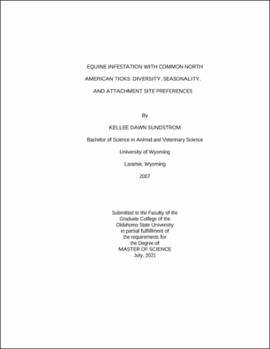| dc.description.abstract | Ticks are common on horses, and the species and stages infesting horses have been documented in many regions of the world. However, recent publications characterizing equine tick infestations in North America are lacking, especially documentation of attachment site preferences and seasonality from the same geographic location throughout the year. To further understand attachment site preferences of common ticks of horses, and to document the seasonality of equine tick infestation in northeastern Oklahoma, horses from eight farms were evaluated twice a month over a one-year period. Each horse was systematically inspected beginning at the head and moving caudally to the tail. Attachment site of ticks was recorded and all ticks collected and identified to species and stage. A total of 2,731 ticks were collected; 84.1% (74/88) of the horses were infested (median=2 ticks) at one or more examinations. Five tick species were identified, including Amblyomma americanum (78.2%; 2,136/2,731), Ixodes scapularis (18.2%; 497/2,731), Dermacentor albipictus brown variant (2.6%; 71/2,731), D. variabilis (0.7%; 20/2,731), and A. maculatum (0.3%; 7/2,731). Most ticks were adults (83.6%; 2,282/2,731), but immature A. americanum (436/2,136; 20.4%), D. albipictus (12/71; 16.9%), and A. maculatum (n=1) were occasionally recovered. Amblyomma americanum were most often attached to the inguinal area, and I. scapularis and D. albipictus were most commonly found on the chest and axillary region (P < 0.0001). Ticks were found on horses in every month of the year. The largest number of ticks (638/2,731; 23.4%) were collected in May (P < 0.0001). Amblyomma americanum, primarily immature, was the only tick recovered in September, I. scapularis and D. albipictus predominated October through February, and both A. americanum and I. scapularis were common in March. In the warmer months, April through August, A. americanum was the most common tick, followed by D. variabilis and A. maculatum. This research confirms that ticks common on horses in North America have attachment site preferences, and that ticks infest horses in Oklahoma throughout the year, including during the winter. Additional research is warranted to fully understand the risk these infestations pose to equine health and to investigate an effective tick control for equids. | |
